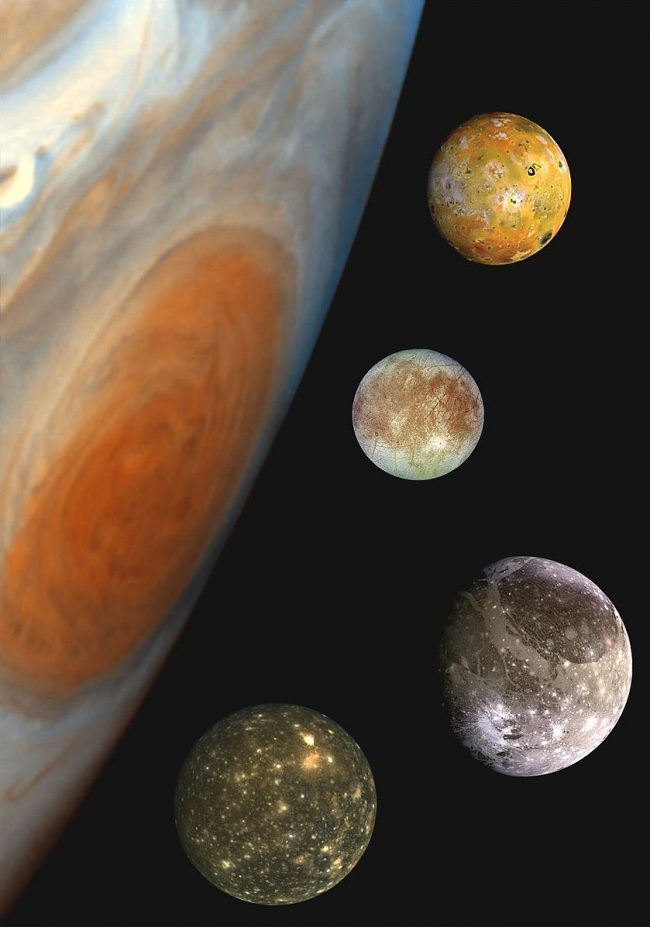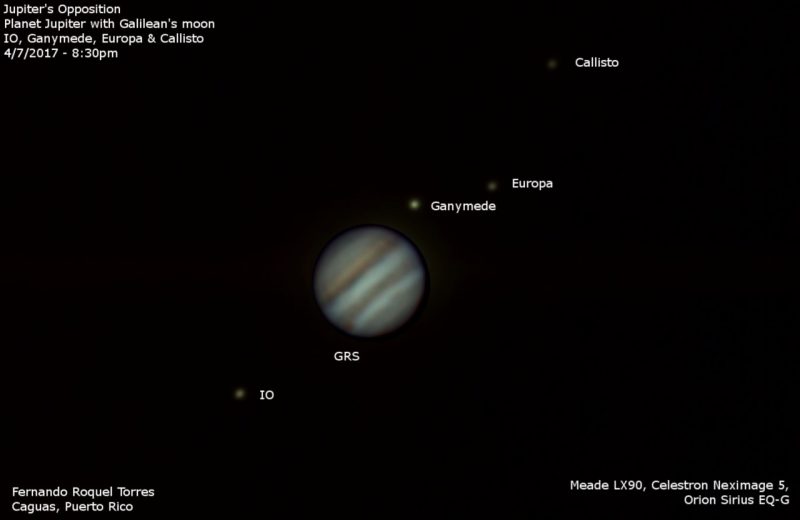

Composite image of Jupiter and its 4 Galilean moons. From top to bottom the moons are Io, Europa, Ganymede, Callisto. The Galileo spacecraft obtained the images to make this composite in 1996. Image via NASA PhotoJournal.
If you have binoculars or a telescope, it’s fairly easy whenever Jupiter is visible to see the giant planet’s four largest moons. They look like pinpricks of light – like tiny “stars” – all on or near the same plane crossing the planet. They’re often called the Galilean moons to honor Galileo, who discovered them in 1610.
In their order from Jupiter, these moons are Io, Europa, Ganymede and Callisto.
Writing in 2014 at SkyandTelescope.com, Kelly Beatty said:
… put a low-power eyepiece in your telescope and center Jupiter. Focus carefully so that the planet’s edge is as sharp as possible, let any vibrations settle down, and then take a good long look.
Depending on the size of your scope and the quality of the night’s seeing … you’ll probably see all four, but possibly only three depending on when you look. The count often changes from night to night (or if you’re patient, even from hour to hour). That’s because while orbiting Jupiter they sometimes glide in front of the planet, behind it, or through its shadow.
These hide-and-seek movements confounded Galileo Galilei when he first spied these ‘stars’ in 1610. But he soon realized they were actually circling around Jupiter, forming a miniature solar system of sorts. We see their orbits almost exactly edge on.
…Callisto is usually (but not always) farthest from Jupiter, and Ganymede is a little brighter than the others. Sulfur-coated Io has a pale yellow-orange cast. Still not sure? The answers are just a mouse clicks away, thanks to SkyandTelescope.com’s handy guide to identifying the Galilean satellites at any time and date.

Fernando Roquel Torres in Caguas, Puerto Rico, captured Jupiter, the Great Red Spot (GRS) and all 4 of its largest moons – the Galilean satellites – on the date of Jupiter’s 2017 opposition (April 7).

Jupiter and three of its four Galilean satellites, as they would appear in a small telescope. Illustration via SkyandTelescope.com.
As Kelly said, the Galilean moons orbit Jupiter around its equator. We do see their orbits almost exactly edge-on, but, as with so much in astronomy, there’s a cycle for viewing the edge-on-ness of Jupiter’s moons. This particular cycle is six years long. That is, every six years, we view Jupiter’s equator – and the moons orbiting above its equator – most edge-on.
And that’s why, in 2015, we were able to view a number of mutual events (eclipses and shadow transits) involving Jupiter’s moons, through telescopes.
Starting in late 2016, Jupiter’s axis began tilting enough toward the sun and Earth so that the outermost of the four moons, Callisto, has not been passing in front of Jupiter or behind Jupiter, as seen from our vantage point. This will continue for a period of about three years, during which time Callisto is perpetually visible to those with telescopes, alternately swinging above and below Jupiter as seen from Earth.
Click here for a Jupiter’s moons almanac, courtesy of SkyandTelescope.com.
Click here for recommended sky almanacs; they can tell you Jupiter’s rising time in your sky.
Bottom line: How to see Jupiter’s moons.
from EarthSky https://ift.tt/2jgkncu


Composite image of Jupiter and its 4 Galilean moons. From top to bottom the moons are Io, Europa, Ganymede, Callisto. The Galileo spacecraft obtained the images to make this composite in 1996. Image via NASA PhotoJournal.
If you have binoculars or a telescope, it’s fairly easy whenever Jupiter is visible to see the giant planet’s four largest moons. They look like pinpricks of light – like tiny “stars” – all on or near the same plane crossing the planet. They’re often called the Galilean moons to honor Galileo, who discovered them in 1610.
In their order from Jupiter, these moons are Io, Europa, Ganymede and Callisto.
Writing in 2014 at SkyandTelescope.com, Kelly Beatty said:
… put a low-power eyepiece in your telescope and center Jupiter. Focus carefully so that the planet’s edge is as sharp as possible, let any vibrations settle down, and then take a good long look.
Depending on the size of your scope and the quality of the night’s seeing … you’ll probably see all four, but possibly only three depending on when you look. The count often changes from night to night (or if you’re patient, even from hour to hour). That’s because while orbiting Jupiter they sometimes glide in front of the planet, behind it, or through its shadow.
These hide-and-seek movements confounded Galileo Galilei when he first spied these ‘stars’ in 1610. But he soon realized they were actually circling around Jupiter, forming a miniature solar system of sorts. We see their orbits almost exactly edge on.
…Callisto is usually (but not always) farthest from Jupiter, and Ganymede is a little brighter than the others. Sulfur-coated Io has a pale yellow-orange cast. Still not sure? The answers are just a mouse clicks away, thanks to SkyandTelescope.com’s handy guide to identifying the Galilean satellites at any time and date.

Fernando Roquel Torres in Caguas, Puerto Rico, captured Jupiter, the Great Red Spot (GRS) and all 4 of its largest moons – the Galilean satellites – on the date of Jupiter’s 2017 opposition (April 7).

Jupiter and three of its four Galilean satellites, as they would appear in a small telescope. Illustration via SkyandTelescope.com.
As Kelly said, the Galilean moons orbit Jupiter around its equator. We do see their orbits almost exactly edge-on, but, as with so much in astronomy, there’s a cycle for viewing the edge-on-ness of Jupiter’s moons. This particular cycle is six years long. That is, every six years, we view Jupiter’s equator – and the moons orbiting above its equator – most edge-on.
And that’s why, in 2015, we were able to view a number of mutual events (eclipses and shadow transits) involving Jupiter’s moons, through telescopes.
Starting in late 2016, Jupiter’s axis began tilting enough toward the sun and Earth so that the outermost of the four moons, Callisto, has not been passing in front of Jupiter or behind Jupiter, as seen from our vantage point. This will continue for a period of about three years, during which time Callisto is perpetually visible to those with telescopes, alternately swinging above and below Jupiter as seen from Earth.
Click here for a Jupiter’s moons almanac, courtesy of SkyandTelescope.com.
Click here for recommended sky almanacs; they can tell you Jupiter’s rising time in your sky.
Bottom line: How to see Jupiter’s moons.
from EarthSky https://ift.tt/2jgkncu

Aucun commentaire:
Enregistrer un commentaire